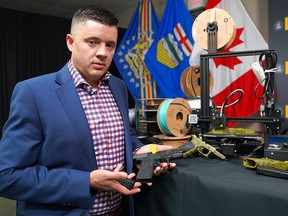Source of half the guns seized by CPS remains a mystery
Acting Staff Sgt. Ben Lawson, with the CPS firearms investigative unit, said his still-new department is working to find the source of every gun that is seized

Article content
Calgary Police Service investigators don’t know the source of about half of the guns seized by officers, but officials say recent legislation could help police track more weapons in the years ahead.
Acting Staff Sgt. Ben Lawson, with the CPS firearms investigative unit, said his still-new department — working with the service’s forensic firearms and toolmark lab — is working to find the source of every gun that is seized.
The CPS data — available for 2021 and 2022 year-to-date — shows about half of the seized guns have no determined source.
In 2021, 53 per cent of seized guns had an undetermined origin. Of the rest, nine per cent were from break-ins, five per cent were smuggled across a border, three per cent were trafficked within Canada and one per cent were homemade or 3D printed.
Last year, 23 per cent of seized guns were lawfully owned, but officials cautioned that number was skewed heavily by a single seizure of 73 guns from a licensed individual.
So far this year, CPS had data available for 142 completed investigations, although more than 320 guns have been seized, with the number climbing.
Of the guns that had a full investigation this year, 50 per cent had no determined source, six per cent were lawfully owned, 13 per cent came from a break-in, 11 per cent were smuggled across the border, nine per cent were trafficked within Canada and nine per cent were homemade or 3D printed.

The data show the prevalence of printed handguns and smuggled handguns is on the rise. Lawson is hoping to get better results on the unknowns, but says that will take time.
“A large majority of the unknowns are because there hasn’t been any record of the non-restricted firearms,” said Lawson. “That law has changed with Bill C-71. Now, gun stores are required to keep records of non-restricted firearm purchases, which mirrors the current gun laws in the U.S.”
He said in future years, he expects police will be able to track more stolen firearms back to their original, lawful owners.
Kelly Sundberg, a criminologist with Mount Royal University, said the data show the country’s current gun regulations are sufficient.
“Crimes committed by legitimate firearms owners or owners who acquired their firearms legitimately are incredibly low, which supports the notion that the laws are working,” he said.
But he sees room for improvement.
Sundberg said based on his research, the Canadian Border Services Agency has about 8,000 officers who seize about 1,000 guns per year. But he said police services across Canada are turning up many more smuggled guns, meaning border officials are missing a lot.
The other alarming trend Sundberg would like to see addressed is manufacturing and 3D printing of illegal “ghost guns.”
“There needs to be all hands on deck figuring out how to address the issue of ghost guns,” he said. “But the spike in ghost guns we saw in Calgary from one per cent to nine per cent, this is reflective of other jurisdictions, not just in the United States but around the world.”
CPS made a major bust in August involving 3D-printed firearms, which resulted in 66 charges against two Calgary men.
Sundberg suggested 3D printers and certain polymers used in those printers may need to be better tracked and regulated, in the same way certain chemicals commonly used for drug manufacturing are restricted.
A new approach
The CPS firearms investigation unit started as a pilot in April 2020 with the task of answering two main questions: how many crime guns does the service seize, and where are they coming from?
“We’ve always known our numbers, as far as how many guns we seize in a year, because we can just run those numbers. But we didn’t have a detailed look as to where they’re being sourced,” said Lawson.
He said the unit is in the process of becoming formalized and permanent within the service. Officers will work in partnership with the service’s independent forensic firearms and toolmark lab on investigations.
Lawson said the lab is staffed with civilians — three scientists and two lab technicians — and is independent to maintain the scientific integrity of their work, which is ultimately bound for the courts.
When the unit begins an investigation, Lawson said members look for the history of the gun starting with the manufacturer and its journey to the hands of a criminal. They usually begin by searching the Canadian National Firearms Tracing Centre, but have various tools at their disposal.
Lawson said the firearms investigative unit will not only help solve crimes once they happen, but also prevent future crimes.
“The work that the lab does allows us to identify offenders that are involved in gun trafficking or gun smuggling at a quicker pace, and we can then target individuals with the firearms investigative unit,” he said.
Lawson said the unit’s investigations especially help the organized crime unit by providing solid investigative leads and helping match seized firearms with past shootings.
CPS is one of only three municipal agencies in Canada with its own firearms lab, which Lawson said helps speed up investigations of gun crime.
“When we talk about turnaround times from shooting evidence and shooting scenes, we can turn around that stuff faster than probably most agencies in the country because we do everything in-house and everything is done with experts,” he said.
brthomas@postmedia.com
Twitter:@brodie_thomas















Postmedia is committed to maintaining a lively but civil forum for discussion. Please keep comments relevant and respectful. Comments may take up to an hour to appear on the site. You will receive an email if there is a reply to your comment, an update to a thread you follow or if a user you follow comments. Visit our Community Guidelines for more information.